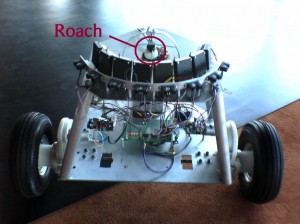
I’m not a big fan of cockroaches, and that goes double for the giant hissing kind. So I find Garnet Hertz’s RoachBot to be both interesting and revolting. Hertz, working at UC Irvine, built a three wheeled robot with a trackball on top that controlled its movement. On that trackball, he secured a giant hissing cockroach from Madagascar, allowing the insect’s scurrying to guide where the robot moved. The roach, in turn, was guided by lights on the robot that shined in the direction of nearby objects. This primitive cyborg demonstrated how biology and robotics could be combined to form a powerful device capable of navigating dynamic terrain. It also fascinated crowds.
The RoachBot project is actually a few years old (2006) and no longer in development. Earlier this month Hertz earned his PhD from Irvine in Visual Studies. That’s right, he’s not a robotics engineer by trade, but rather an artist (and Fullbright Scholar). Hertz’ many projects explore how technology, reality, and creativity merge together. In that way, RoachBot is as much commentary as it is experiment. The cockroach has been an important inspiration in robotics, and engineers mimicked its design in robots like DASH. Likewise, cyborgs have captivated imaginations with the unique molding of biology and machine in a way that often captivates and repulses us. The RoachBot concept has merit as an engineering design – World War II scientists used a similar system to have pigeons guide missiles. More importantly though, RoachBot generates interest in the field of cybernetics with its uncanny and engrossing take on the living machine. Cool stuff…and congrats, Dr. Hertz, on your doctorate.
[photo and video credit: Garnet Hertz]


